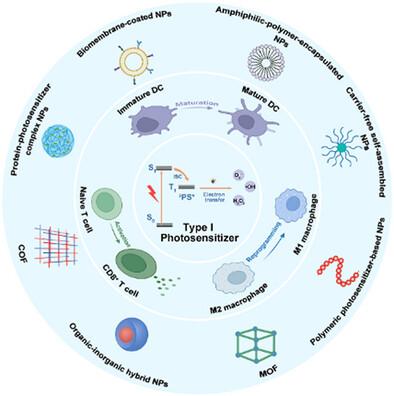Advances in Nanotechnology‐Driven Enhancement of Type I Photosensitizers for Tumor Photo‐Immunotherapy
IF 12.1
2区 材料科学
Q1 CHEMISTRY, MULTIDISCIPLINARY
引用次数: 0
Abstract
The integration of photodynamic therapy (PDT) with immunotherapy (photo‐immunotherapy, PIT) has emerged as a promising strategy for improving cancer treatment outcomes. Unlike oxygen‐dependent type II PDT, electron‐transfer‐driven type I PDT generates a diverse spectrum of reactive oxygen species (ROS), including superoxide anion and hydroxyl radicals. These radicals induce stronger oxidative stress, promote the release of tumor‐associated antigens, and trigger damage‐associated molecular patterns. Such effects offer potential advantages under the hypoxic conditions that are common in solid tumors. However, small‐molecule photosensitizers still face intrinsic drawbacks, including rapid systemic clearance, limited tumor accumulation, and weak immunogenicity. These limitations remain formidable obstacles to clinical application. To enhance therapeutic efficacy and immune‐stimulatory potential, a variety of nanomaterials have been engineered. In this context, a comprehensive overview of recent advances in nanomaterial‐based type I PIT is both timely and essential. This review summarizes progress in this area, emphasizing design strategies, ROS generation mechanisms, and immunomodulatory effects. It also discusses key clinical transformation challenges and future directions to guide the rational design of next‐generation PIT nanoplatforms. Collectively, these advances highlight promising opportunities for more effective and selective nanotechnology‐driven strategies, while further research is required to evaluate their clinical potential.

纳米技术驱动增强I型光敏剂用于肿瘤光免疫治疗的研究进展
光动力疗法(PDT)与免疫疗法(光免疫疗法,PIT)的结合已成为改善癌症治疗结果的一种有前途的策略。与依赖氧的II型PDT不同,电子转移驱动的I型PDT产生多种活性氧(ROS),包括超氧阴离子和羟基自由基。这些自由基诱导更强的氧化应激,促进肿瘤相关抗原的释放,并触发损伤相关的分子模式。这种效果在实体瘤中常见的缺氧条件下提供了潜在的优势。然而,小分子光敏剂仍然面临着固有的缺点,包括快速的全身清除、有限的肿瘤积累和弱的免疫原性。这些限制仍然是临床应用的巨大障碍。为了提高治疗效果和免疫刺激潜力,各种纳米材料已经被设计出来。在这种情况下,全面概述纳米I型PIT的最新进展是及时和必要的。本文综述了该领域的研究进展,重点介绍了ROS的设计策略、生成机制和免疫调节作用。本文还讨论了关键的临床转化挑战和未来方向,以指导下一代PIT纳米平台的合理设计。总的来说,这些进展强调了更有效和选择性的纳米技术驱动策略的有希望的机会,同时需要进一步的研究来评估它们的临床潜力。
本文章由计算机程序翻译,如有差异,请以英文原文为准。
求助全文
约1分钟内获得全文
求助全文
来源期刊

Small
工程技术-材料科学:综合
CiteScore
17.70
自引率
3.80%
发文量
1830
审稿时长
2.1 months
期刊介绍:
Small serves as an exceptional platform for both experimental and theoretical studies in fundamental and applied interdisciplinary research at the nano- and microscale. The journal offers a compelling mix of peer-reviewed Research Articles, Reviews, Perspectives, and Comments.
With a remarkable 2022 Journal Impact Factor of 13.3 (Journal Citation Reports from Clarivate Analytics, 2023), Small remains among the top multidisciplinary journals, covering a wide range of topics at the interface of materials science, chemistry, physics, engineering, medicine, and biology.
Small's readership includes biochemists, biologists, biomedical scientists, chemists, engineers, information technologists, materials scientists, physicists, and theoreticians alike.
 求助内容:
求助内容: 应助结果提醒方式:
应助结果提醒方式:


